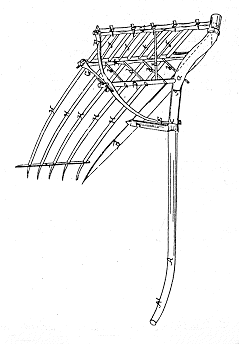
A threshing machine or a thresher is a piece of farm equipment that threshes grain, that is, it removes the seeds from the stalks and husks. It does so by beating the plant to make the seeds fall out.

Cyrus Hall McCormick was an American inventor and businessman who founded the McCormick Harvesting Machine Company, which later became part of the International Harvester Company in 1902. Originally from the Blue Ridge Mountains of Virginia, he and many members of his family became prominent residents of Chicago.

A scythe is an agricultural hand tool for mowing grass or reaping crops. It has largely been replaced by horse-drawn and then tractor machinery, but is still used in some areas of Europe and Asia.

The modern combine harvester, or simply combine, is a versatile machine designed to efficiently harvest a variety of grain crops. The name derives from its combining three separate harvesting operations—reaping, threshing, and winnowing—into a single process. Among the crops harvested with a combine are wheat, oats, rye, barley, corn (maize), sorghum, soybeans, flax (linseed), sunflowers and canola. The separated straw, left lying on the field, comprises the stems and any remaining leaves of the crop with limited nutrients left in it: the straw is then either chopped, spread on the field and ploughed back in or baled for bedding and limited-feed for livestock.

A reaper is a farm implement or person that reaps crops at harvest when they are ripe. Usually the crop involved is a cereal grass. The first documented reaping machines were Gallic reaper that was used in modern-day France during Roman times. The Gallic reaper involved a comb which collected the heads, with an operator knocking the grain into a box for later threshing.

A mower is a person or machine that cuts (mows) grass or other plants that grow on the ground. Usually mowing is distinguished from reaping, which uses similar implements, but is the traditional term for harvesting grain crops, e.g. with reapers and combines.

A sickle, bagging hook or reaping-hook, is a single-handed agricultural tool designed with variously curved blades and typically used for harvesting, or reaping, grain crops or cutting succulent forage chiefly for feeding livestock, either freshly cut or dried as hay. Falx was a synonym but was later used to mean any of a number of tools that had a curved blade that was sharp on the inside edge such as a scythe.

Harvesting is the process of gathering a ripe crop from the fields. Reaping is the cutting of grain or pulse for harvest, typically using a scythe, sickle, or reaper. On smaller farms with minimal mechanization, harvesting is the most labor-intensive activity of the growing season. On large mechanized farms, harvesting utilizes the most expensive and sophisticated farm machinery, such as the combine harvester. Process automation has increased the efficiency of both the seeding and harvesting process. Specialized harvesting equipment utilizing conveyor belts to mimic gentle gripping and mass transport replaces the manual task of removing each seedling by hand. The term "harvesting" in general usage may include immediate postharvest handling, including cleaning, sorting, packing, and cooling.

The reaper-binder, or binder, is a farm implement that improved upon the simple reaper. The binder was invented in 1872 by Charles Baxter Withington, a jeweler from Janesville, Wisconsin. In addition to cutting the small-grain crop, a binder also 'binds' the stems into bundles or sheaves. These sheaves are usually then 'shocked' into A-shaped conical stooks, resembling small tipis, to allow the grain to dry for several days before being picked up and threshed.
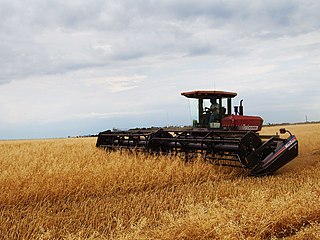
A swather, or windrower, is a farm implement that cuts hay or small grain crops and forms them into a windrow. "Swather" is predominantly the North American term for these machines. In Australia and other parts of the world, they are called "windrowers". They aid harvesting by speeding up the process of drying the crop down to a moisture content suitable for harvesting and storage.
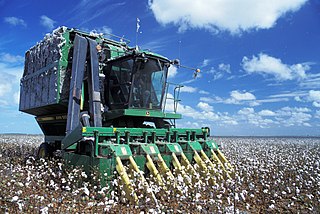
Mechanised agriculture is the process of using agricultural machinery to mechanise the work of agriculture, greatly increasing farm worker productivity. In modern times, powered machinery has replaced many farm jobs formerly carried out by manual labour or by working animals such as oxen, horses and mules.

A harvest festival is an annual celebration that occurs around the time of the main harvest of a given region. Given the differences in climate and crops around the world, harvest festivals can be found at various times at different places. Harvest festivals typically feature feasting, both family and public, with foods that are drawn from crops that come to maturity around the time of the festival. Ample food and freedom from the necessity to work in the fields are two central features of harvest festivals: eating, merriment, contests, music and romance are common features of harvest festivals around the world.

The Cyrus McCormick Farm and Workshop is on the family farm of inventor Cyrus Hall McCormick known as Walnut Grove. Cyrus Hall McCormick improved and patented the mechanical reaper, which eventually led to the creation of the combine harvester. The farm is near Steele's Tavern and Raphine, close to the northern border of Rockbridge and Augusta counties in the U.S. state of Virginia, and is currently a museum run by the Virginia Agricultural Experimental Station of Virginia Tech. The museum has free admission and covers 5 acres (2.0 ha) of the initial 532-acre (215.3 ha) farm.

A dragsaw or Drag saw is a large reciprocating saw using a long steel crosscut saw to buck logs to length. Prior to the popularization of the chainsaw during World War II, the dragsaw was a popular means of taking the hard work out of cutting wood. They would only work for a log on the ground. Dragsaws are known as the first mechanical saws to be used in the timber industry operation. These tools were most useful in the logging business, because they were efficient and very resilient. Not to be confused with Steam donkey.
Rev Patrick Bell was a Church of Scotland minister and inventor.
John Francis Appleby (1840–1917) was an American inventor who developed a knotting device to bind grain bundles with twine. It became the foundation for all farm grain binding machinery and was used extensively by all the major manufacturers of large grain harvesting machines in the late 19th and early 20th centuries. Appleby's knotting device was a major landmark in the mechanization of agriculture and aided the development of the western wheat fields of the United States.
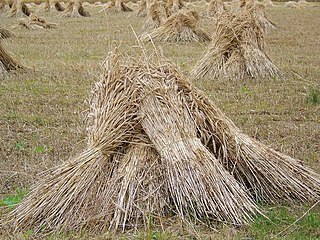
A sheaf (/ʃiːf/) is a bunch of cereal-crop stems bound together after reaping, traditionally by sickle, later by scythe or, after its introduction in 1872, by mechanical reaper-binder
Stripper was a type of harvesting machine common in Australia in the late 19th and early 20th century. John Ridley is now accepted as its inventor, though John Wrathall Bull argued strongly for the credit.
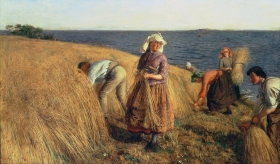
A bandwin was a team of agricultural workers in the Scottish Lowlands before the agricultural revolution, who carried out the harvest.


